It looks like one of the northern specimens of Eurytides (or whatever) marcellus, the Zebra Swallowtail: white with a few thin black stripes, and usually with a long "tail" tip on each hind wing. Only it's not in the northern part of its range where marcellus looks like that. It's in the southern part, typically Mexico, where Zebras are bigger and seem clearly to be black with a few pale green stripes. Its wings may be more transparent, and they show a red stripe that can run the full length of the underside of the hind wing. A close observer like Jeffrey Glassberg, of Swift Guide fame, would note that it has a broader pale area on the outside edge of the forewings than other striped Swallowtails, this pale area often almost completely scaleless and transparent. It's a different butterfly. Different sources give it different names, but it's most often called Eurytides (or whatever) epidaus, the Mexican Kite.
Guatemalans prefer to call it the Guatemalan Kite. The names Long-tailed Kite, Pale Kite, and White Kite are also found, and some people just feel that with its black and white stripes, the butterfly has to qualify as some sort of Zebra. Though it feeds on another tree in the genus Annona and looks closely related to the State Butterfly of Tennessee, they don't hybridize.
Two views of one butterfly from tropicleps.ch.
In Spanish kites, the toys, are cometas, and so are Kite Swallowtails. In Mexico this one is the Mariposa cometa de cola golondrina mexicana. In casual speech this might be shortened to cometa golondrina mexicana. Cola means a tail, golondrina means a swallow bird, mariposa means a butterfly. That's a mouthful, but the subspecies epidaus is the m.c. de c.g.m. del golfo, the Gulf Mexican Kite Swallowtail Butterfly.
In Latin Eurytides means "broad shape," describing the wings in contrast to the Longwing butterfly family's wings. Protographium means "first, earliest Graphium," expressing faith that the Graphium genus evolved from this genus; Neographium has also been used, expressing faith that this genus evolved from the Graphium genus. (Many sources prefer Eurytides, but a majority of the more scholarly sources published online use Protographium.) Epidaus was not the name of a major hero of ancient literature, but may be a short form of Epidaurus, which is the name of a town in Greece whose origin story used to claim that it was named for its founder. Tepicus and fenochionis identify the western subspecies with places.
Lots of people have photographed this butterfly and drawn pictures of it. A picture of epidaus was used on postage in Nicaragua; the stamps can still be bought from Colnect. There are a few epidaus videos online:
This short Twitter video shows the butterfly licking a man's finger, suggesting that epidaus is one of the Swallowtail species in which males participate in "puddling," the Swallowtails' form of a behavior scientists call "lekking." In some animal species unpaired males hang out in groups called "leks," sometimes jousting for status, sometimes just waiting to reach mating age. In Swallowtails the lekking sites are sources of shallow, usually polluted, liquid, which contain the mineral salts the male butterflies need. Females need the minerals too, but usually absorb their share through contact with males and sip only clean water, flower nectar, and occasionally fruit juice. Thus, although females are primarily pollinators, in some Swallowtail species males are composters. However, their taste in minerals varies; some male Swallowtails are attracted to dung and carrion and even motor oil, while others meet their mineral needs by sipping bitter or brackish water.
This longer video, narrated in Spanish, offers a close-up view of the caterpillar, magnified enough that you can see that (like all "hairless" caterpillars) it actually does have short fine hair, and can see it leaving tiny trails where it licks the leaf, or the woman's finger. You can see its pulse. I think I even see an internal parasite--its skin is translucent as its wings will be, if it lives to grow wings. A real test of tolerance for caterpillar gross-outs...Well. No. The video includes no frass and no shell eating. The really disgusting part of the video was the advertisement. If I don't describe it, maybe you'll see a different, less disgusting one.
The same woman narrates a much prettier video documenting the life cycle of a butterfly who starts out with a different pattern of cryptic coloration from any of the caterpillars photographed below, pupates on a potted plant, and emerges as a butterfly whose forewings never have scales along the outer edges. Also in Spanish.
Butterflies inspired artwork even before Columbus' time. Ancient butterfly images were not drawn from life so it's hard to be sure which species were portrayed, but some ancient butterfly carvings clearly seem to have been inspired by Swallowtails. Possibly by Mexican Kites.
Ryan Fessenden's videos aren't as informative as they might be, but one of them did give me a chortle. As most butterfly fanciers know, one of the other butterfly families that are generally smaller than the Swallowtails is known as the Whites. One species of White butterfly was given the name pamela, so it's the Pamela White. It happens that some female Pamela Whites are not white. All of them have colored markings, but some of them are, primarily...brown! Fessenden doesn't say it--it's too easy--but he shows us a photo of what logically ought to be called the Pamela Brown! (There's a family of butterflies that are normally brown; they are, illogically, called the Nymphs and Satyrs, which leaves "Pamela Brown" available as a nickname for brown-winged Pamela Whites.)
(Young people may not get it. "Pamela Brown" was a song, the national anthem of all young adults who enjoyed being bachelors, back when people my age were young adults.
This Brazilian site, set up to address the questions of insect-phobic readers, mentions that epidaus is one of the Swallowtails that smell "bad." It opened in Portuguese for me; I used Google Translate to get the quoted word "bad." It does not tackle the question of whether epidaus is only a primary pollinator, or the primary pollinator, for custard-apples, the fruit of Annona reticulata, which local humans eat. (Custard-apples have been considered the most important member, economically, of a plant/fruit family that also includes pawpaws, soursops, sweetsops, cherimoya and more.)
Scientists currently recognize three subspecies. In fact individual variation makes it hard to define how to classify an individual in a subspecies without knowing where it was found. Eduardo Nuple Juarez has at least proposed a math-based rule for classification.
E. epidaus epidaus is found in the eastern parts of Mexico and Central America. It appears on checklists for Belize, Costa Rica, El Salvador, Guatemala, Honduras, Mexico, and Nicaragua. (If by any chance you're going to visit one of those countries, you can use those links to download a printable checklist.) Their forewings tend to become scaleless and transparent only in the pale stripe at the outer edge. Their wings can look pale green in some lights, as Zebra Swallowtails' wings do.
E. epidaus tepicus and E.e. fenochionis are found in northwestern and southwestern Mexico, respectively. Tepicus was recognized as a subspecies by Rothschild et al. in 1906; fenochionis has sometimes been listed as a separate species. Their forewings can be transparent all the way across the top edge. The pattern of wing striping and scale loss differs just noticeably.
They live in forests that have distinct "wet" and "dry" seasons. They sip water from shallow puddles and wet sand. Fenochionis, at least, seem to tolerate one another's company...
Flock of fenochionis "puddling" from momoto-erick at inaturalist.mma.gob.cl. That site, and others, also document that small groups of these butterflies sometimes mingle with larger groups of mixed species while puddling.
This photo essay is primarily about a similar-looking species, P. (or E.) dariensis, but contains photos of the life cycle of P. (or E.) epidaus. The text is in Spanish, but (1) scientific jargon is meant to be internationally accessible, so it's easy Spanish, and (2) translation software.
Ah, here's the site I really wanted. Well, Google did put it nearer the top than that other site. Their write-up of epidaus paints a peculiar picture. Butterfly reproduction takes place by means of a spermatophore, or "sperm package," transferred from male to female. As the outer covering of the "package" dissolves, it breaks down into those minerals the females are too nice to slurp up out of polluted puddles, and other nutrients. Viable sperm cells join with ova; less viable sperm material is digested along with the outer coat of the spermatophore. Acguanacaste makes it sound as if the female reached inside herself and sorted out the sperm cells, which of course she doesn't. What she spends her time doing, with her voluntary muscles, is finding suitable leaves and laying eggs by ones. Sperm selection is part of her job, in a manner of speaking, but it's a set of chemical reactions that take place inside her.
Eggs are laid by ones, and resemble little white beads. Annona reticulata is listed as the usual host plant, with some sources mentioning that the butterflies may also use Annona glabra and some species of Rollinia.
Caterpillars don't try to look like centipedes. Their skin is relatively smooth. This hatchling shows the white "belt" marking found on many other baby Swallowtails.
They have the humpbacked body shape that conceals an osmeterium.
Though not all caterpillars show this top/side contrast color pattern, it probably has some survival value. It falls into the category of cryptic coloration. A predator looking at this pattern might have to look twice to realize that it was looking at a small, slow-moving, not highly toxic, really almost defenseless little animal.
Caterpillar sequence from ButterfliesOfAmerica.com. These are relatively small caterpillars; they will become relatively small butterflies, for Swallowtails. All fenochionis shown matured from black to green; some specimens of E. epidaus epidaus went through an orange stage:
The photographer known as Syntheticpurples didn't say what person did to get this individual to put out its osmeterium, nor whether its bird-repellent scent was unpleasant or even noticeable to humans.
Photo from inaturalist.ala.org.au. This caterpillar's lower sides look almost exactly like the leaf on which it's sitting...now that's camouflage!
As shown in the video above, although these caterpillars don't use silk to pull leaves together around themselves, make nests, or wrap their chrysalides in cocoons, they do drool as continually as other caterpillars, and their saliva hardens into silk. Benodelacruz does not explain how he kept this caterpillar drooling on his fingertip long enough to produce a visible layer of silk. Usually, when caterpillars can taste that they're walking on something inedible, they keep walking until they come to the kind of leaf they can eat.
"Mature" caterpillars are 3 to 4 cm long, less than 2 inches, and adult butterflies' wingspan is usually given as 4 to 5 cm. Some butterflies reportedly measure 3 inches or more across the wings.


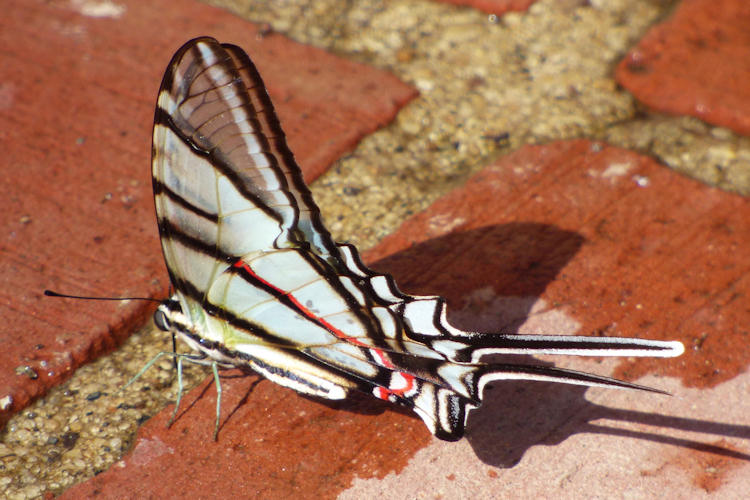
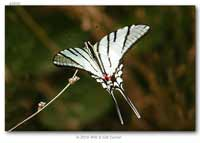

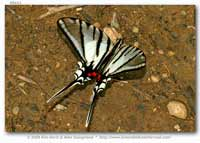


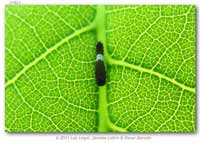


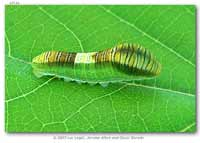






No comments:
Post a Comment